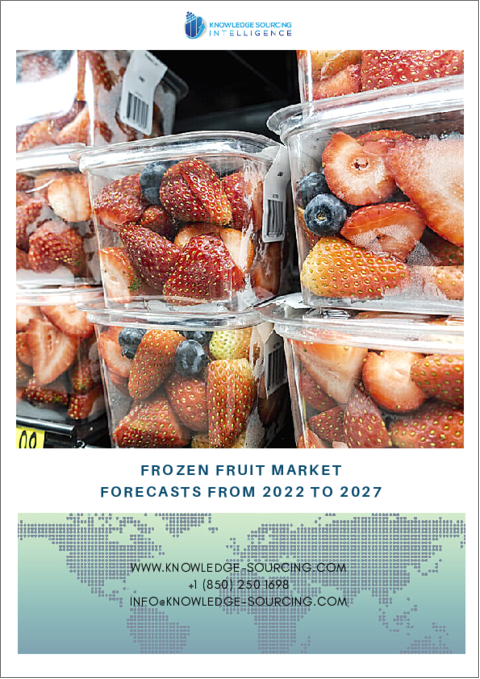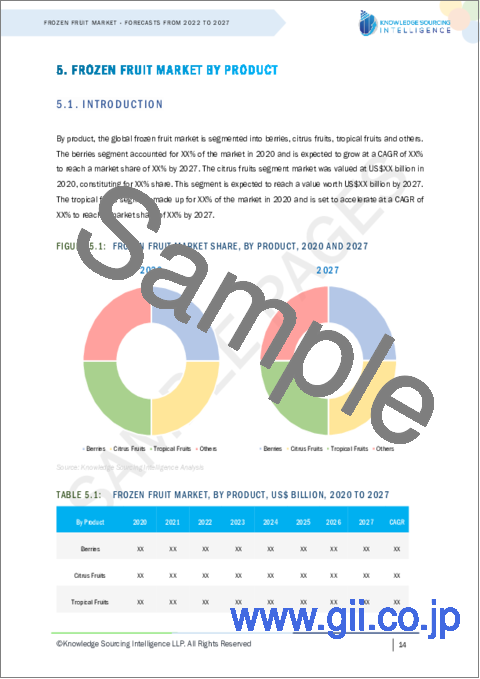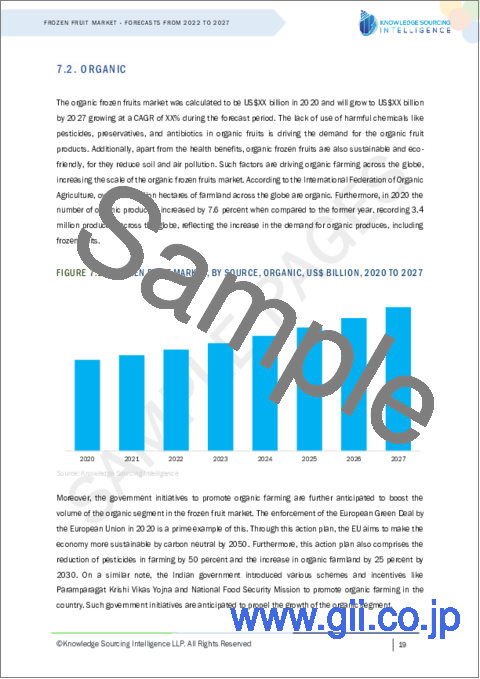|
|
市場調査レポート
商品コード
1122619
冷凍フルーツの世界市場予測(2022年~2027年)Frozen Fruit Market - Forecasts from 2022 to 2027 |
||||||
|
● お客様のご希望に応じて、既存データの加工や未掲載情報(例:国別セグメント)の追加などの対応が可能です。 詳細はお問い合わせください。 |
|||||||
| 冷凍フルーツの世界市場予測(2022年~2027年) |
|
出版日: 2022年08月24日
発行: Knowledge Sourcing Intelligence
ページ情報: 英文 128 Pages
納期: 即日から翌営業日
|
- 全表示
- 概要
- 目次
世界の冷凍フルーツの市場規模は、2020年の40億3,400万米ドルから、2027年には63億6,600万米ドルに達し、予測期間中に6.74%のCAGRで成長が予測されています。
エキゾチックフルーツに対する需要の増加、特に食品加工企業の急成長に伴う冷凍技術の進歩による季節に限定されないフルーツの年間を通した可用性、急速な都市化、様々な食品・飲料製品における冷凍食品の用途拡大、関連する健康効果としての認知度向上などが、冷凍フルーツ市場の基盤となる要因となっています。成長に結びつくさらなる要因は、食品包装の急速な技術革新、可処分所得の増加、オフライン・オンライン小売スペースの拡大です。しかし、COVID-19で起きた貿易の混乱が、冷凍フルーツの市場動向にある程度の下降線を描く見通しです。
当レポートでは、世界の冷凍フルーツ市場について調査分析し、市場概要、市場力学、市場分析、競合情勢、企業プロファイルなど、体系的な情報を提供しています。
目次
第1章 イントロダクション
- 市場の定義
- 市場の内訳
第2章 調査手法
- 調査データ
- 前提条件
第3章 エグゼクティブサマリー
- 調査のハイライト
第4章 市場力学
- 市場促進要因
- 市場抑制要因
- ポーターのファイブフォース分析
- 供給企業の交渉力
- 買い手の交渉力
- 新規参入業者の脅威
- 代替品の脅威
- 業界における競争企業間の敵対関係
- 業界バリューチェーン分析
第5章 冷凍フルーツ市場分析:製品別
- イントロダクション
- ベリー
- シトラスフルーツ
- トロピカルフルーツ
- その他
第6章 冷凍フルーツ市場分析:形状別
- イントロダクション
- 丸ごと
- キューブ
- スライス
- その他
第7章 冷凍フルーツ市場分析:供給元別
- イントロダクション
- 有機
- 無機
第8章 冷凍フルーツ市場分析:用途別
- イントロダクション
- 有機菓子類・ベーカリー
- ジャム・保存食
- フルーツベース飲料
- 乳製品
第9章 冷凍フルーツ市場分析:流通チャネル別
- イントロダクション
- オンライン
- オフライン
第10章 冷凍フルーツ市場分析:地域別
- イントロダクション
- 北米
- 米国
- カナダ
- 南米
- ブラジル
- アルゼンチン
- その他
- 欧州
- ドイツ
- 英国
- フランス
- イタリア
- その他
- 中東・アフリカ
- サウジアラビア
- アラブ首長国連邦
- その他
- アジア太平洋
- 中国
- 日本
- インド
- 韓国
- 台湾
- タイ
- インドネシア
- その他
第11章 競合環境と分析
- 主要企業と戦略分析
- 新興企業と市場収益性
- 合併・買収・合意・提携
- ベンダーの競合マトリクス
第12章 企業プロファイル
- Val-Mex Frozen Foods, LLC
- Willamette Valley Fruit Company
- Antillal
- De Marchi and Industry Fruits Ltda
- Dawtona Frozen
- Greenyard
- Euroberry Pty Ltd
- Cold Alex
- Entyce Food Ingredients Pty Ltd
- Tomco Produce Group Co Limited
Frozen Fruit Market size is expected to grow at a compound annual growth rate of 6.74% over the forecast period to reach a market size of US$6.366 billion in 2027 from US$4.034 billion in 2020.
Increasing demand for exotic fruits, a yearlong availability of non-seasonal fruits, especially due to advancements in refrigeration technologies coupled with rapid growth in food processing firms, rapid urbanization, and growing application of frozen food in a variety of food and beverage products as well the rising cognizance as associated health benefits are a few factors which are fundamental to the frozen fruit market. Additional factors responsible for the growth are rapid innovations in food packaging, growing availability in disposable income, and expanding offline and online retail space. Also, the consumption of frozen fruit is preferred because it is considered better than canned and dehydrated fruit. Above all, the sensorial characteristics are comparatively well retained along with nutritional aspects. Nevertheless, the trade disruption experienced during COVID-19 is expected to create a downward draft in the frozen fruit Market Trends: to a certain extent.
The European region is expected to hold a substantial share of the global frozen fruit market and facilitate the anticipated growth of the same. The primary reason which is expected to bring the aforementioned in effect is the growing inclination toward consuming food that is easy to prepare and nutritious at the same time. Except in certain regions with their microclimate, tropical fruits cannot be cultivated throughout Europe. Thus, the growing markets of Eastern Europe, as well as Europe, offer many opportunities for the growth of this market. For example, in June 2020, it was announced that Waitrose & Partners was conducting a trial of a refillable zone that has been reported to be the UK's first borrow-a-box scheme and the first frozen 'pick and mix' made available in supermarkets. The concept reportedly includes frozen blueberries, cherries, mango, pineapple, raspberries, and strawberries. Earlier in 2018, Grupo Virto, an organization which is based out of Spain and is known for the production and distribution of deep-frozen vegetables had reportedly acquired Oerlemans Foods Group, which is a privately owned producer and supplier of freshly frozen vegetables and fruit in the Netherlands, intending to strengthen its position in the growing international market for freshly frozen fruit, among others. Moreover, in June 2020, it was reported that Casalfiumanese (Bologna) base company Agrimola which engages in frozen and semi-processed fruit, among others, reportedly acquired Montecchio Maggiore (Vicenza) based La Nuova Tradizione with the backing of FondoAgroalimentareItaliano complementing the former's portfolio with the latter's semi-processed and finished fruit products for patisseries and ice-cream parlours sold under the Vergani 1881 brand. Besides, from 2018, the consumption registered during the preceding five years has increased by an annual growth rate of 6.0%. Belgium, France, Germany, and the United Kingdom are the largest markets for frozen berries. However, Belgium is home to several large frozen processing companies. Most imported frozen berries are not sold within the country but re-exported or further processed, reportedly emerging as a trade hub. The largest importers of frozen berries are Germany, with a reported total import value of €371 million in 2018. Imports by Germany reportedly increased by 6.7% in volume per annum between 2014 and 2018, to 250 thousand tons [ Source: Ministerie van Landbouw, NatuurenVoedselkwaliteit].
Frozen tropical fruits and berries are expected to occupy a significant market share enabling the growth of the global frozen fruit market around the world. Berries have emerged as one of the most frequently desired fruit because of their increasing cognizance as a super-fruit due to the naturally occurring high amounts of antioxidants and other nutrients. The demand for berries has been further propelled by the increasing popularity of a variety of healthy snacking options and smoothies, among others, and the rising innovation in food products leading to its use by the food processing industry. According to the estimates by Ministerie van Landbouw, NatuurenVoedselkwaliteit, which is the Dutch Ministry responsible for agricultural policy, animal welfare, fisheries, food policy, food safety, forestry, and natural conservation, a stable growth pertaining to frozen berries is expected to be experienced by the European market. Further, reportedly European imports of frozen fruits and berries grew every year by an average of 5.0% in value and 8.0% in volume to a value of €1.5 billion and a quantity of 935 thousand tons in 2018. Thus, the higher growth in volume than in value reported indicates a decrease in import prices over the last five years. Moreover, more than 50% of these European imports of frozen strawberries. Out of the total estimated 500 thousand tons of berries in the European market registered in 2018, The smaller shares are utilized by the retail and foodservice channels, and the largest quantities are used by the fruit processing industry.
The already expanding retail distribution channels, along with an increasing upswing in eCommerce due to COVID-19, which also reinforced the need for healthy consumption, are expected to augment the growth of the frozen fruit market. For instance, in September 2020, it was reported that Food Forever Pty Ltd, a company that is known to cater to a variety of food service and retail consumers across both Australia and New Zealand - has launched Ra, which is essentially a new retail brand that offers frozen fruits in reusable and recyclable trays. The frozen chunks of raspberries, mango, and blueberries that were to be made commercially available are all certified as sustainably grown by the Rainforest Alliance. Further, Los Angele's first vegan ice cream truck by Frozen Fruit Co. was reported to expand with retail options in September 2020. Another instance is the planned launch of frozen fruit bars reported in June 2020, which have been reportedly infused with adaptogens by a brand called Beyond Better Foods LLC, which is based out of New York. In August 2020, it was reported that Minneapolis-based retailer Target was to make Good & Gather products commercially available, which are inclusive of but not limited to frozen fruit, among others. In January 2020, it was reported that a local frozen fruit brand named Seal the Seasons received authorization for distributing its products among retailers who are based out of Arizona and California. According to the announcement, local frozen fruit will be available in more than 3000 conventional and natural retailers. It has also been reported that it is the first company to freeze fruit which is regionally produced across retailers throughout the year. In April 2020, it was reported that multinational retail giant Tesco and Greenyard Frozen UK have entered into a strategic partnership to facilitate the supply of Tesco's full range of frozen fruits, among others, leading to an increase in volume and making the widest frozen fruit portfolio commercially available to customers.
Key Developments
Owing to the growing increasing demand for exotic and seasonal fruits, as well as with the increasing advancements in the refrigeration industry, the frozen fruit market has seen tremendous growth.
In May 2022, Hortifrut announced the opening of a new distribution centre in Ireland as well as collaboration in India to help the company extend its reach. This was done to participate directly in emerging consumer trends and to keep our European and Asian expansions on track, where they expect to see the most growth in the future.
Iceland and Del Monte have teamed up to launch a huge new frozen fruit line. In May 2021, Iceland and The Food Warehouse launched an exclusive range of Del Monte® frozen fruits in stores and online. From Del Monte® Lime Slices to Del Monte® Orange Slices, the collection contained 11 types of the finest frozen fruits.
Impact of COVID-19 pandemic
The COVID-19 viral outbreak resulted in a spike in infection rates, prompting nations throughout the world to initiate global lockdowns. As a result, market demand for frozen fruit decreased as most manufacturing and supply links were disrupted. Since most agricultural producers were unable to supply their produced fruits to frozen fruit manufacturers, the market demand suffered. With the closure of supermarkets and frozen food stores, the market demand decreased substantially. Furthermore, with the majority of sectors already resuming operations, the frozen fruit market is expected to grow in demand.
Segmentation
- By Product
Berries
Citrus Fruits
Tropical Fruits
Others
- By Form
Whole
Cubed
Sliced
Others
- By Source
Organic
Inorganic
- By Distribution Channel
Online
Offline
- By Application
Confectionery and Bakery
Dairy Products
Fruit Based Beverages
Jams & Preserves
- By Geography
North America
- USA
- Canada
- Mexico
South America
- Brazil
- Argentina
- Others
Europe
- Germany
- UK
- France
- Italy
- Others
Middle East and Africa
- Egypt
- South Africa
- Others
Asia Pacific
- China
- Japan
- India
- South Korea
- Taiwan
- Thailand
- Indonesia
- Others
TABLE OF CONTENTS
1. Introduction
- 1.1. Market Definition
- 1.2. Market Segmentation
2. Research Methodology
- 2.1. Research Data
- 2.2. Assumptions
3. Executive Summary
- 3.1. Research Highlights
4. Market Dynamics
- 4.1. Market Drivers
- 4.2. Market Restraints
- 4.3. Porter's Five Forces Analysis
- 4.3.1. Bargaining Power of Suppliers
- 4.3.2. Bargaining Power of Buyers
- 4.3.3. Threat of New Entrants
- 4.3.4. Threat of Substitutes
- 4.3.5. Competitive Rivalry in the Industry
- 4.4. Industry Value Chain Analysis
5. Frozen Fruit Market Analysis, By Product
- 5.1. Introduction
- 5.2. Berries
- 5.3. Citrus Fruits
- 5.4. Tropical Fruits
- 5.5. Others
6. Frozen Fruit Market Analysis, By Form
- 6.1. Introduction
- 6.2. Whole
- 6.3. Cubed
- 6.4. Sliced
- 6.5. Others
7. Frozen Fruit Market Analysis, By Source
- 7.1. Introduction
- 7.2. Organic
- 7.3. Inorganic
8. Frozen Fruit Market Analysis, By Application
- 8.1. Introduction
- 8.2. Organic Confectionery and Bakery
- 8.3. Jams & Preserves
- 8.4. Fruit Based Beverages
- 8.5. Dairy Products
9. Frozen Fruit Market Analysis, By Distribution Channel
- 9.1. Introduction
- 9.2. Online
- 9.3. Offline
10. Frozen Fruit Market Analysis, By Geography
- 10.1. Introduction
- 10.2. North America
- 10.2.1. USA
- 10.2.2. Canada
- 10.3. South America
- 10.3.1. Brazil
- 10.3.2. Argentina
- 10.3.3. Others
- 10.4. Europe
- 10.4.1. Germany
- 10.4.2. UK
- 10.4.3. France
- 10.4.4. Italy
- 10.4.5. Others
- 10.5. Middle East and Africa
- 10.5.1. Saudi Arabia
- 10.5.2. UAE
- 10.5.3. Others
- 10.6. Asia Pacific
- 10.6.1. China
- 10.6.2. Japan
- 10.6.3. India
- 10.6.4. South Korea
- 10.6.5. Taiwan
- 10.6.6. Thailand
- 10.6.7. Indonesia
- 10.6.8. Others
11. Competitive Environment and Analysis
- 11.1. Major Players and Strategy Analysis
- 11.2. Emerging Players and Market Lucrativeness
- 11.3. Mergers, Acquisitions, Agreements, and Collaborations
- 11.4. Vendor Competitiveness Matrix
12. Company Profiles
- 12.1. Val-Mex Frozen Foods, LLC
- 12.2. Willamette Valley Fruit Company
- 12.3. Antillal
- 12.4. De Marchi and Industry Fruits Ltda
- 12.5. Dawtona Frozen
- 12.6. Greenyard
- 12.7. Euroberry Pty Ltd
- 12.8. Cold Alex
- 12.9. Entyce Food Ingredients Pty Ltd
- 12.10. Tomco Produce Group Co Limited




